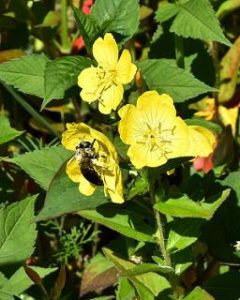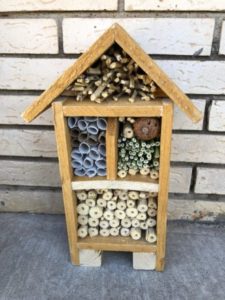by Josie Gonzalez, El Paso Master Gardener
Bees, wasps, butterflies, moths, flies, and some beetles pollinate more than seventy percent of flowering plants. These important insects are called pollinators. Although bats, birds, and even lemurs can pollinate flowers, the vast majority of pollinating animals, world-wide, are insects.
According to the National Academy of Sciences, close to seventy-five percent of the flowering plants on earth rely to some degree on pollinators to set seeds or fruit. One-third of the food for humans comes from flowering plants and an even greater proportion of the food for our wildlife comes from them.
Although beautiful healthy plants are able to emerge without pollinators, no fruits or seeds are generated. Some El Paso gardeners have experienced this dilemma only to find themselves pollinating their vegetables with cotton swabs and tiny paint brushes. If you are one of these unfortunate gardeners, you have experienced the importance of pollinators or rather the lack of pollinators. Here are a few ideas that may help you to attract more pollinators to your garden.
Mother Nature gave us the hints on how to do it. Many plants developed flowers with brilliantly colored petals and bright green foliage. Pollinators use petals and leaves to land on and rest. Attractive smells advertise a plant’s presence. These plants attract pollinators and are well suited to our area:
- Desert Willow (Chilopsis linearis) for bees and hummingbirds,
- Gregg’s Prairie Clover aka Trailing Indigo Bush (Dalea greggii) for bees,
- Hartweg’s Sundrop aka Western Primrose (Calylopus hartwegii) for moths,
- Ocotillo (Fouquieria splendens) for hummingbirds, and
- Rainbow Cactus (Echinocereus pectinatus) for bees and butterflies.
Once you have attracted pollinators, keep them in your garden by providing areas for them to nest. Wooden nest blocks (available from catalogs or feed stores) and bundles of hollow bamboo-like stems set in a coffee can or bucket help pollinators make a home.
Colletes bees, mining bees, and other ground-nesting bees sometimes excavate soil around a hole in the ground just as ants do. When you find what appear to be deserted ant hills in your garden, allow them to remain intact. These just may be the home of your garden pollinators. Leave some bare and unmulched ground in which ground bees are able to nest. They especially like sunny areas and south-facing slopes.

Credit: Insect Hotel Bees Wood Block by Counselling (CC0 1.0)
A very important tip to keeping pollinators in your garden is to use pesticides responsibly. If you have a problem that seems to require a pesticide, look for an alternative. By using plant species appropriate to local conditions, you can often avoid plant diseases in the first place. There are ways to help non-native plants outgrow many diseases and keep insect pests away without pesticides. If your neighbors use pesticides, work with them to find a chemical-free way to minimize the pesticides’ impact. Hand picking and crushing larger insects or spraying a stream of soapy water to dislodge smaller plant pests is a practical and effective way to avoid pesticides use.
There is a delicate balance to everything in nature, even pollinating. Taking action to assist pollinators, however small, is better than taking none at all. The U.S. Senate recognizes the urgent issue of declining pollinator populations. In 2007, with Resolution 580, it designated the last week of June as National Pollinator Week and created http://www.pollinator.org/ to house a variety of resources. Another helpful government website is Pollinators by the U.S. Fish & Wildlife Service.
Pollinators positively affect our lives – let’s protect them and celebrate them.

